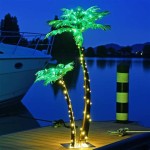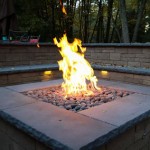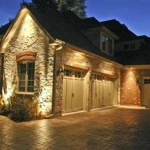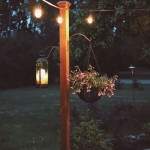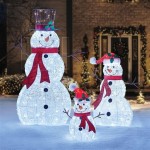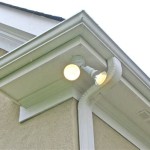Outdoor Flood Lighting Ideas: Illuminating Your Property with Style and Security
Outdoor flood lighting serves a multitude of purposes, extending far beyond simple illumination. It enhances security, improves visibility, accentuates architectural features, and creates ambiance for outdoor living spaces. Selecting the right flood lighting requires careful consideration of several factors, including the intended purpose, the size and layout of the property, the architectural style of the building, and local lighting regulations. This article explores various outdoor flood lighting ideas, offering insights into different types of fixtures, placement strategies, and considerations for achieving optimal results.
Understanding the Purpose of Outdoor Flood Lighting
The initial step in planning outdoor flood lighting is to define its primary purpose. Security lighting aims to deter potential intruders by illuminating vulnerable areas such as entry points, dark corners, and perimeters. This type of lighting often utilizes motion sensors and bright, focused beams. Conversely, accent lighting focuses on highlighting specific features like landscaping, architectural details, or water features. Accent lighting typically employs softer, more diffuse light sources and strategic placement to create visual interest. Area lighting provides general illumination for outdoor spaces such as patios, decks, and driveways, ensuring safe passage and usability after dark. The intended purpose significantly influences the choice of fixtures, their placement, and the overall lighting design.
A comprehensive understanding of the property's vulnerabilities and aesthetic goals is crucial. Identifying potential blind spots, areas prone to trespass, and architectural elements that deserve highlighting forms the basis of a successful lighting plan. Furthermore, considering the typical use of outdoor spaces after dark informs the intensity and type of lighting needed. For instance, a patio used for evening gatherings requires warmer, more ambient lighting, while a driveway benefits from brighter, more functional illumination.
Neighborly considerations are also paramount. Excessive or poorly directed lighting can create light pollution and disturb neighbors. Careful aiming of floodlights, the use of shields or hoods, and adherence to local lighting ordinances can mitigate these issues. Opting for downward-facing fixtures and lower light levels in residential areas promotes responsible and considerate lighting practices.
Types of Outdoor Flood Lighting Fixtures
The market offers a wide array of outdoor flood lighting fixtures, each with its own set of characteristics and applications. Traditional floodlights utilize halogen or incandescent bulbs, known for their high light output and relatively low cost. However, these bulbs are energy-intensive and have a shorter lifespan compared to newer technologies. LED (Light Emitting Diode) floodlights have emerged as a popular alternative due to their energy efficiency, long lifespan, and versatility. LED fixtures consume significantly less energy than traditional bulbs, reducing electricity bills and minimizing environmental impact. They are also available in various color temperatures, allowing for greater control over the ambiance. Solar-powered floodlights offer a sustainable and cost-effective option for areas where wiring is challenging or impractical. These fixtures harness solar energy during the day to power the lights at night, eliminating the need for electricity and reducing carbon footprint.
Beyond the light source, the fixture design also plays a crucial role. Adjustable floodlights allow for precise aiming of the light beam, enabling targeted illumination of specific areas. Motion-activated floodlights provide an added layer of security, automatically turning on when movement is detected, deterring potential intruders and conserving energy. Integrated floodlights combine the light source and fixture into a single unit, offering a streamlined and aesthetically pleasing appearance. These fixtures are often used for accent lighting and general area illumination.
The choice of fixture material also impacts its durability and resistance to weather elements. Cast aluminum, stainless steel, and powder-coated finishes provide excellent protection against corrosion, ensuring that the fixtures withstand the rigors of outdoor use. Selecting fixtures with a high IP (Ingress Protection) rating is essential for ensuring their resistance to dust and water ingress. An IP rating of IP65 or higher is recommended for outdoor flood lighting applications.
Strategic Placement and Installation Techniques
Effective flood lighting hinges on strategic placement and proper installation. Mounting height is a crucial factor influencing the coverage area and light distribution. Higher mounting heights provide wider coverage but may also increase glare. Lower mounting heights offer more focused illumination but may limit the overall reach of the light. Experimentation with different mounting heights is often necessary to achieve the desired balance between coverage and glare reduction. Angling floodlights downward minimizes light pollution and directs the light where it is needed most. Shielding the lights with hoods or visors further reduces glare and prevents light from spilling into neighboring properties.
Consider the architectural features of the building and the surrounding landscape when determining the placement of floodlights. Highlighting architectural details such as columns, arches, and gables can enhance the visual appeal of the property. Uplighting trees and shrubs can create a dramatic and inviting atmosphere. Downlighting from eaves or trees can provide soft, ambient illumination for pathways and patios. Strategic placement of floodlights can transform the appearance of a property and create a sense of depth and dimension.
Proper installation is essential for ensuring the safety and longevity of outdoor flood lighting. Consulting a qualified electrician is recommended, especially when dealing with electrical wiring. Securely mounting the fixtures to a stable surface is crucial to prevent them from falling or being damaged by wind. Using weatherproof connectors and conduit protects the wiring from moisture and ensures a safe and reliable electrical connection. Regularly inspect the fixtures and wiring for any signs of damage or wear and tear, and promptly address any issues to prevent potential hazards.
Integrating flood lighting with a smart home system offers enhanced control and automation. Smart floodlights can be controlled remotely via a smartphone app, allowing for adjusting brightness, color temperature, and scheduling. Motion sensors can be integrated with security systems to trigger alerts when movement is detected. Voice control integration enables hands-free operation of the lights. Smart flood lighting systems offer convenience, energy savings, and enhanced security features.
Choosing the appropriate color temperature for outdoor flood lighting can significantly impact the ambiance and perceived safety of a space. Warmer color temperatures (2700K-3000K) create a cozy and inviting atmosphere, suitable for patios and outdoor living areas. Cooler color temperatures (4000K-5000K) provide brighter, more functional illumination, ideal for security lighting and driveways. Selecting the right color temperature depends on the intended purpose of the lighting and the desired aesthetic.
Maintenance is an often-overlooked aspect of outdoor flood lighting. Regularly cleaning the lenses of the fixtures ensures optimal light output and prevents dirt and debris from accumulating. Replacing burnt-out bulbs promptly maintains consistent illumination levels. Periodically checking the wiring and connections for any signs of corrosion or damage prevents electrical hazards. Investing in high-quality fixtures and performing routine maintenance extends the lifespan of the lighting system and ensures its reliable performance.
When planning an outdoor flood lighting project, it's beneficial to sketch out the layout of the property and mark the desired locations for the fixtures. This visual aid helps in visualizing the overall lighting design and identifying any potential obstacles or challenges. Consider the existing landscape features, architectural details, and the surrounding environment when planning the placement of the lights. A well-thought-out lighting plan maximizes the effectiveness of the flood lighting and enhances the overall aesthetic appeal of the property.

Outdoor Flood Lighting Ideas At Electrical Supplies

8 Best Flood Lights In 2024 Our Top Picks

How To Choose The Best Led Outdoor Flood Lights

How To Install Outdoor Floodlights True Value

30 Diy Lighting Ideas At Night Yard Landscape With Outdoor Lights Gowritter Garden Landscaping

Why Buy Led Flood Lights Types Uses Htm Lighting
The 7 Best Ways To Light Up Your Backyard Sansbury Electric

Taifond 20 Watt 150 Degree Black Motion Activated Integrated Led Security Outdoor Flood Light Ofl0122 The Home Depot

The Basic Requirements Of Flood Light Fixture For Architectural Facade Agc Lighting

130 个 Led Flood Light 点子
